Vision of the future
What will influence the MRO industry over the next 10 years? Consultant David Stewart gazed into his crystal ball and this is what he saw ....
At this year's MRO USA conference in Fort Lauderdale, Florida, David Stewart, principal consultant at consultancy Aerostrategy, ventured to present a snapshot of the support landscape in which the world's airlines will attempt to keep their aircraft flying.
"The whole idea was just to make people think," says Stewart. "A good 50% of this may be wrong, but we believe people need to plan against all the elements that will influence the MRO industry over the next 10 years."
He believes there is nothing too "left field" within this vision and believes that most are quite reasonable assumptions. "It is pretty certain that there will be consolidation in the airframe MRO business with the emergence of three or four players globally," he says.
 |
|---|
Stewart predicts that 75% if air transport MRO will be outsourced in 2017 |
THE MARKET IN 2018
So here goes: in 2018, the air transport fleet numbers 28,000 aircraft. The fleet is heavily concentrated on two aircraft models, the Airbus A320 and Boeing 737 from the world's two major airframers, whose families combine to represent around 48% of the fleet.
With an enterprising degree of stealth, they have together locked in 50% of those single-aisle customers with integrated MRO contracts that include airframe/component maintenance, rotable logistics and/or fleet management options, thereby leveraging their key strengths in aircraft health management systems and distribution networks to increase competitiveness.
The global fleet has increased by 9,000 aircraft since 2007, a 4% compound annual growth rate with the installed base of 27,966 aircraft comprising 6,128 future orders, 7,314 firm orders, 206 parked aircraft and 14,318 aircraft in the retained fleet.
The Asian and European fleets in 2018 are nearly the same size as the North America base. Orders stand at 6,900 aircraft, with new single-aisle aircraft accounting for 41%. Boeing and Airbus launched their next-generation models in 2014 and 2016 respectively - together representing 41% of the orderbook.
The Boeing 787, introduced in 2009, now accounts for 4% of the active fleet with more than 1,200 aircraft in service, while the A350XWB comprises 18% of the orderbook.
A recent move by both airframers to launch new widebody designs to replace the Airbus A330/A340 families and Boeing 777 has resulted in 300 orders from airline customers.

Over the intervening decade, the air transport and MRO sectors have both restructured significantly. North American airlines have consolidated to four majors with an average fleet size of 500 aircraft.
Green aviation policies prevail following the USA's ratification of the Kyoto II Protocol in 2011, while in the early 2010s foreign ownership rules were finally liberalised. Major internal MRO facilities, meanwhile, have been either divested or spun-out.
Elsewhere, the Middle East fleet has doubled since 2007 with Dubai becoming an important MRO and aviation hub. In line with the trend to lower cost labour bases, African MRO bases have emerged.
"Snecma already has an engine maintenance presence and rumours in the industry currently doing the rounds suggest that Air France Industries is looking at this region as well for airframe work," says Stewart.
CARRIERS DWINDLE
Within Europe, transatlantic open-skies liberalisation has led to the consolidation and subsequent disappearance of several leading flag carriers, while low-cost carriers have dwindled from a high of 45 to less than 15.
In Asia-Pacific, liberalisation has facilitated numerous start-ups since 2007, while the Chinese fleet has tripled, absorbing most MRO capacity growth. Interestingly, Japan and South Korea have both emerged as engine and component MRO locations.
The 2017 MRO market is worth $61 billion, a $15 billion increase since 2007. Modifications account for $5.3 billion (a 2.8% compound annual growth rate), heavy airframes $7.2 billion, and the component business - the highest compound annual growth rate at 3.9% - $13.3 billion.

Line maintenance work is valued at $13.1 billion, while engine MRO totals $22.4 billion of annual work, a 3.8% compound annual growth rate.
In total, air transport MRO accounts for 45% of a broader $140 billion global maintenance market, with outsourcing at 75% - up from 52% 10 years previously, although this could yet be owned or partially owned by airlines.
Around 90% of engine MRO, 30% of line maintenance, 85% of component support and 75% of heavy airframe maintenance support is outsourced.
Captive engine maintenance has declined significantly due to independents gaining market share with the spinning out of captive MRO facilities.
While OEMs have moved to licensed service centres and formed joint ventures for some engine models to offset the threat of parts manufacture approval, they have however retained the largest share and control 50% of the engine overhaul market.
In terms of airframe heavy maintenance, the independents have become the chief beneficiaries of the outsourcing trend, offsetting the effects of slow market growth and gaining significant market share, with five major global suppliers controlling more than 40% of the market.
| MRO SECTOR ROUNDUP |
|---|
We chart key recent market developments as part of our regular series of maintenance special reports Work has started on a new Air Berlin Group maintenance hangar at Düsseldorf airport. The hangar will be able to simultaneously house three widebody aircraft. Air Berlin is consolidating its maintenance operation following its acquisition of Düsseldorf-based LTU and its earlier absorption of budget operator DBA. The new hangar, 220m (720ft) long and 90m wide, is east of the terminal, next to an LTU hangar – giving maintenance personnel access to both. Lufthansa Technik is considering shifting a significant amount of A318 Elite cabin completion work to its Tulsa, Oklahoma-based maintenance, completions and handling subsidiary, BizJet International, in an effort to fulfil a booming orderbook for the smallest member of the A320-based Airbus Corporate Jetliner family. The A318 Elite workload could even see the German MRO specialist make an announcement about extending BizJet’s capabilities as early as this May’s European Business Aviation Convention and Exhibition in Geneva. Chinese MRO company Taikoo (Xiamen) Aircraft Engineering (TAECO) is working to become Asia’s first approved cabin completion centre for Airbus corporate aircraft. It has signed an agreement with Airbus to help create a completion centre in China for corporate offerings of the manufacturer’s aircraft. TAECO is majority-owned by Hong Kong Aircraft Engineering, and Boeing holds a minority stake. Airbus North America Customer Services has contracted Goodrich to repair a variety of proprietary components at its Foley, Alabama MRO facility. Under the agreement, the Goodrich Alabama Service Center becomes one of two Airbus-endorsed repair stations for structural components in the Americas, and is now one of three repair stations in the Americas selected by Airbus to work on proprietary parts. The main product lines Goodrich expects to maintain include flight-control services and pneumatic ducting and access doors, such as landing gear doors. Lufthansa Technik is to start work this month on a €10 million ($16 China’s new civil aviation minister is urging the country’s airlines to operate more dedicated freighters, giving a fillip to MRO company Ameco Beijing’s ambitions to enter the freighter conversion business. The newly-appointed director general of the Civil Aviation Administration of China, Li Jiaxiang, has told the country’s state-run media that Chinese airlines had a 44% market share for air cargo to and from China in 2000, but this has now fallen to 18%. Chinese airlines need to win back market share from foreign carriers, says Li, adding that if they fail they will be marginalised in the international air cargo market. US-based Ametek Aerospace & Defense continues to grow its MRO business with the opening of a new service centre near Singapore Changi airport by the end of the first quarter. The 1,670m2 (18,000ft2) facility will operate as a unit of Ametek Southern Aeroparts. Amtek in 2006 started an expansion of its MRO business through acquisitions of third-party providers, buying Tulsa, Oklahoma-based Southern Aeroparts, which specialises in hydraulic, pneumatic and electromechanical components and subsystems. Thai Airways International is planning to move into the Airbus A300-600 and Boeing 747-400 freighter conversion business with the help of US firm Flight Structures and Israel Aerospace Industries. The Thai national carrier’s vice-president of heavy maintenance, Chailerk Thipayachan, says the airline is “about to sign the memorandum of understanding with IAI” to carry out 747-400 passenger-to-freighter conversions at Bangkok’s Don Muang airport. The first freighter conversion will be for a third-party customer, says Chailerk. Singapore-based engineering support and training firm Mil-Com is teaming up with Singapore’s Republic Polytechnic to provide a diploma course in aircraft maintenance in an effort to cater to increased demand for skilled and qualified maintenance engineers. The aim is to start the 18-month course in May or June with an intake of 40 students, says Mil-Com vice-president training, Stephen Chung. Mil-Com already provides training courses for industry players such as Singapore Technologies Aerospace, but Chung confirms that – because this new course is provided jointly by Republic Polytechnic – the Singapore government will subsidise it.
|
Source: Flight International























